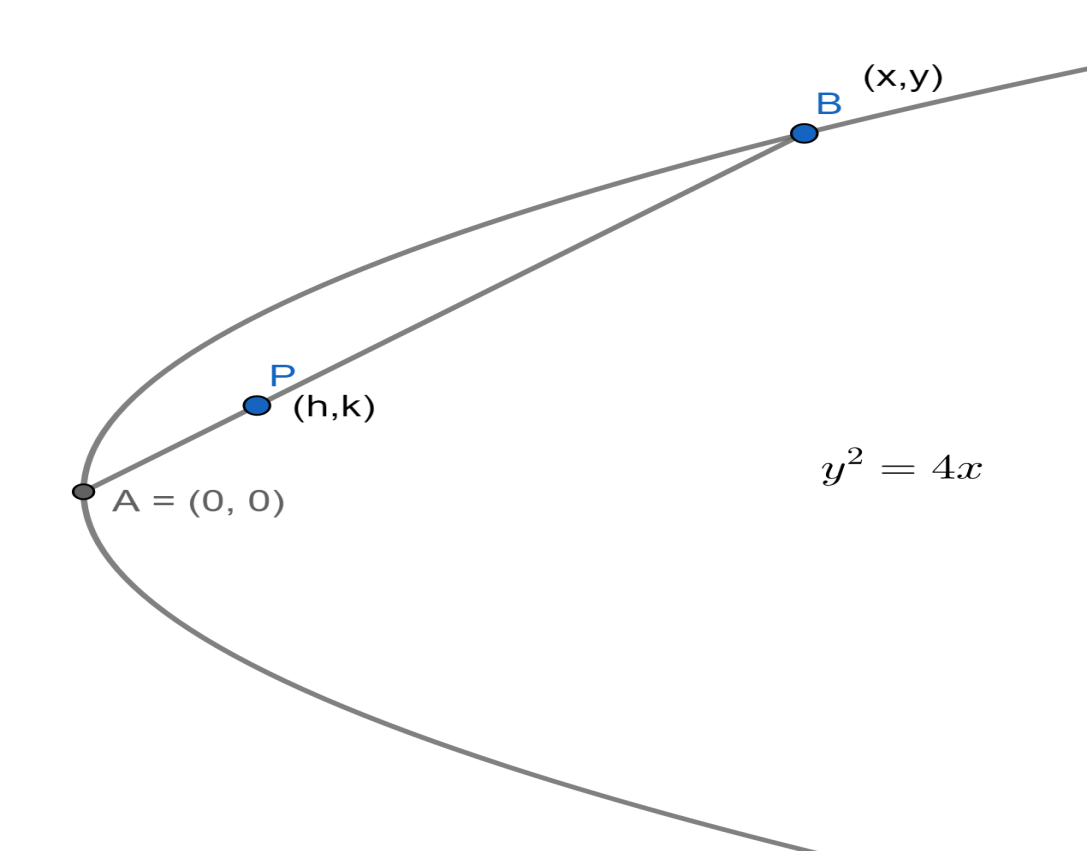
If $\left( x,y \right)$ are any point on the parabola ${{y}^{2}}=4x$ . Let $P$ be the point that divides the line segment from $\left( 0,0 \right)$ to $\left( x,y \right)$ in the ratio $1:3$. Then, the locus of $P$ is:
(1) ${{x}^{2}}=y$
(2) ${{y}^{2}}=2xy$
(3) ${{y}^{2}}=x$
(4) ${{x}^{2}}=2y$
Answer
412.8k+ views
Hint:Here in this question we have been asked to find the locus of $P$ given that $\left( x,y \right)$ is any point on the parabola ${{y}^{2}}=4x$ and $P$ be the point that divides the line segment from $\left( 0,0 \right)$ to $\left( x,y \right)$ in the ratio $1:3$ . To answer this question we will assume the coordinates of $P$ to be $\left( h,k \right)$ and find the condition in which it can divide the line segment.
Complete step-by-step solution:
Now considering from the question we have been asked to find the locus of $P$ given that $\left( x,y \right)$ is any point on the parabola ${{y}^{2}}=4x$ and $P$ be the point that divides the line segment from $\left( 0,0 \right)$ to $\left( x,y \right)$ in the ratio $1:3$ .

From the basic concepts of straight lines, we know that the section formula states that when any point divides the line segment formed by $\left( {{x}_{1}},{{y}_{1}} \right)$ and $\left( {{x}_{2}},{{y}_{2}} \right)$ in the ratio of $m:n$ internally then it is given as $\left( \dfrac{m{{x}_{2}}+n{{x}_{1}}}{m+n},\dfrac{m{{y}_{2}}+n{{y}_{1}}}{m+n} \right)$ .
Let us assume that the coordinates of $P$ are $\left( h,k \right)$.
Now we will use the statement “ $P$ divides the line segment from $\left( 0,0 \right)$ to $\left( x,y \right)$ in the ratio$1:3$” and conclude that $h=\dfrac{1\left( x \right)+3\left( 0 \right)}{1+3}$ and $k=\dfrac{1\left( y \right)+3\left( 0 \right)}{1+3}$ .
Hence $h=\dfrac{x}{4}$ and $k=\dfrac{y}{4}$ .
Since it is given that $\left( x,y \right)$ is located on the parabola ${{y}^{2}}=4x$ we will get
$\begin{align}
& {{\left( 4k \right)}^{2}}=4\left( 4h \right) \\
& \Rightarrow {{k}^{2}}=h \\
\end{align}$ .
Therefore we can conclude that the locus of $P$ will be given as ${{y}^{2}}=x$ .
Hence we will mark the option “3” as correct.
Note:During the process of answering questions of this type we should be sure with the concepts that we are going to apply and calculations that we are going to perform between the steps. If someone had a misconception that the section formula is given as $\left( \dfrac{m{{x}_{1}}+n{{x}_{2}}}{m+n},\dfrac{m{{y}_{1}}+n{{y}_{2}}}{m+n} \right)$ then they will end up having the conclusion as ${{y}^{2}}=3x$ which is not present in the options and a wrong answer.
Complete step-by-step solution:
Now considering from the question we have been asked to find the locus of $P$ given that $\left( x,y \right)$ is any point on the parabola ${{y}^{2}}=4x$ and $P$ be the point that divides the line segment from $\left( 0,0 \right)$ to $\left( x,y \right)$ in the ratio $1:3$ .

From the basic concepts of straight lines, we know that the section formula states that when any point divides the line segment formed by $\left( {{x}_{1}},{{y}_{1}} \right)$ and $\left( {{x}_{2}},{{y}_{2}} \right)$ in the ratio of $m:n$ internally then it is given as $\left( \dfrac{m{{x}_{2}}+n{{x}_{1}}}{m+n},\dfrac{m{{y}_{2}}+n{{y}_{1}}}{m+n} \right)$ .
Let us assume that the coordinates of $P$ are $\left( h,k \right)$.
Now we will use the statement “ $P$ divides the line segment from $\left( 0,0 \right)$ to $\left( x,y \right)$ in the ratio$1:3$” and conclude that $h=\dfrac{1\left( x \right)+3\left( 0 \right)}{1+3}$ and $k=\dfrac{1\left( y \right)+3\left( 0 \right)}{1+3}$ .
Hence $h=\dfrac{x}{4}$ and $k=\dfrac{y}{4}$ .
Since it is given that $\left( x,y \right)$ is located on the parabola ${{y}^{2}}=4x$ we will get
$\begin{align}
& {{\left( 4k \right)}^{2}}=4\left( 4h \right) \\
& \Rightarrow {{k}^{2}}=h \\
\end{align}$ .
Therefore we can conclude that the locus of $P$ will be given as ${{y}^{2}}=x$ .
Hence we will mark the option “3” as correct.
Note:During the process of answering questions of this type we should be sure with the concepts that we are going to apply and calculations that we are going to perform between the steps. If someone had a misconception that the section formula is given as $\left( \dfrac{m{{x}_{1}}+n{{x}_{2}}}{m+n},\dfrac{m{{y}_{1}}+n{{y}_{2}}}{m+n} \right)$ then they will end up having the conclusion as ${{y}^{2}}=3x$ which is not present in the options and a wrong answer.
Recently Updated Pages
The correct geometry and hybridization for XeF4 are class 11 chemistry CBSE

Water softening by Clarks process uses ACalcium bicarbonate class 11 chemistry CBSE

With reference to graphite and diamond which of the class 11 chemistry CBSE

A certain household has consumed 250 units of energy class 11 physics CBSE

The lightest metal known is A beryllium B lithium C class 11 chemistry CBSE

What is the formula mass of the iodine molecule class 11 chemistry CBSE

Trending doubts
Is Cellular respiration an Oxidation or Reduction class 11 chemistry CBSE

In electron dot structure the valence shell electrons class 11 chemistry CBSE

What is the Pitti Island famous for ABird Sanctuary class 11 social science CBSE

State the laws of reflection of light

One Metric ton is equal to kg A 10000 B 1000 C 100 class 11 physics CBSE

Difference Between Prokaryotic Cells and Eukaryotic Cells




